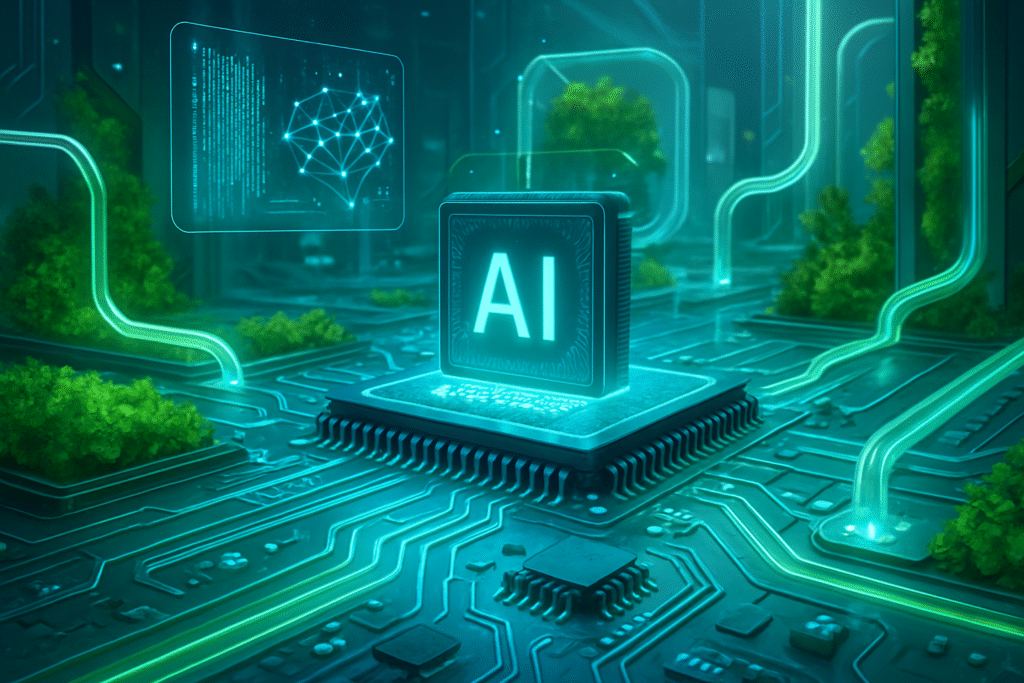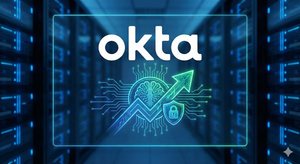Financial News
The Green Revolution in Silicon: Semiconductor Industry Forges a Sustainable Future

The foundational industry powering our digital world, semiconductor manufacturing, is undergoing a profound transformation. Driven by escalating global climate concerns, increasing regulatory pressures, and a growing demand for corporate environmental responsibility, the sector is embarking on an ambitious journey toward sustainability. This shift is not merely an ethical choice but a strategic imperative, with companies investing heavily in green production processes, advanced energy efficiency, and sophisticated water management to drastically reduce their environmental footprint. The immediate significance of these initiatives is paramount: they are crucial for mitigating the industry's substantial energy and water consumption, reducing hazardous waste, and ensuring the long-term viability of technological advancement, particularly in the rapidly expanding field of Artificial Intelligence. As the world increasingly relies on silicon, the push for "green chips" is becoming a defining characteristic of the 21st-century tech landscape.
Engineering a Greener Fab: Technical Innovations Drive Sustainable Production
Traditional semiconductor manufacturing, with its intricate processes and stringent purity requirements, has historically been one of the most resource-intensive industries. However, a wave of technical innovations is fundamentally altering this paradigm. Green production processes are being integrated across the fabrication lifecycle, moving away from a linear "take-make-dispose" model towards a circular, sustainable one.
A significant shift is observed in eco-friendly material usage and green chemistry. Manufacturers are actively researching and implementing safer, less hazardous chemical alternatives, optimizing processes to reduce chemical consumption, and deploying advanced gas abatement technologies to detoxify harmful emissions. This directly reduces the environmental and health risks associated with substances like perfluorinated compounds (PFCs). Furthermore, the industry is exploring localized direct atomic layer processing, a groundbreaking technique that allows for precise, individual processing steps, drastically cutting energy consumption, material waste, and chemical use. This method can reduce heat generation by up to 50% compared to conventional approaches, leading to lower CO2 emissions and less reliance on extensive cleanroom infrastructure.
Advanced energy efficiency measures are paramount, as fabs are among the most energy-intensive sites globally. A major trend is the accelerated transition to renewable energy sources. Companies like Intel (NASDAQ: INTC) aim for 100% renewable electricity use by 2030 and net-zero greenhouse gas (GHG) emissions by 2040. Taiwan Semiconductor Manufacturing Company (TSMC) (NYSE: TSM), the world's largest foundry, signed a monumental power purchase agreement in February 2024 for a 920-megawatt offshore wind farm, projected to supply 25% of its electricity needs by 2026. Beyond sourcing, operational energy efficiency is being enhanced through smart fab designs, advanced cooling systems (including liquid cooling and AI-powered chilled water systems that have saved TSMC 180 GWh of electricity annually), and optimizing HVAC systems. Engineers are also designing energy-efficient chips from the ground up, utilizing low-power design techniques and more efficient transistor architectures.
Sophisticated water management technologies are critical, given that a single large fab can consume millions of gallons of ultrapure water (UPW) daily. The industry is investing heavily in advanced water reclamation and recycling systems, employing multi-stage purification processes like Reverse Osmosis (RO), Ultra-filtration (UF), and electro-deionization (EDI) to achieve high water recovery rates. GlobalFoundries has notably achieved a 98% recycling rate for process water through breakthrough wastewater treatment technology. Efforts also include optimizing UPW production with innovations like Pulse-Flow Reverse Osmosis, which offer higher recovery rates and reduced chemical usage compared to traditional methods. Companies are also exploring alternative water sources like air conditioning condensate and rainwater to supplement municipal supplies.
The AI research community and industry experts view these sustainability efforts with a blend of optimism and urgency. They highlight the pivotal role of AI itself in enabling sustainability, with AI/ML systems optimizing manufacturing processes, managing resources, and enabling predictive maintenance. However, they also acknowledge the dual challenge: while AI helps green the industry, the rapidly increasing demand for powerful AI chips and the energy-intensive nature of AI model training pose significant environmental challenges, making a greener semiconductor industry fundamental for a sustainable AI future. Industry collaboration through initiatives like the Semiconductor Climate Consortium (SCC) and increasing regulatory pressures are further accelerating the adoption of these innovative, sustainable practices.
Reshaping the Tech Landscape: Competitive Implications and Strategic Advantages
The green revolution in silicon is fundamentally reshaping the competitive landscape for AI companies, tech giants, and startups alike. Sustainability is no longer a peripheral concern but a core strategic differentiator, influencing market positioning and investment decisions.
AI companies are directly impacted by the demand for energy-efficient chips. As AI models become more complex and ubiquitous, the energy consumption of data centers, which are the backbone of AI operations, is under intense scrutiny. Companies like NVIDIA (NASDAQ: NVDA) are not just building powerful AI chips but are designing them for significantly less energy consumption, offering a critical advantage in a world striving for greener computing. Google's (NASDAQ: GOOGL) custom TPUs are another prime example of inherently energy-efficient AI accelerators. Moreover, AI itself is proving to be a powerful tool for sustainability, with AI/ML algorithms optimizing fab operations, reducing waste, and managing energy and water use, potentially cutting a fab's carbon emissions by around 15%.
Tech giants such as Apple (NASDAQ: AAPL), Microsoft (NASDAQ: MSFT), and Amazon (NASDAQ: AMZN) face immense pressure from consumers, investors, and regulators to achieve net-zero supply chains. This translates into significant demands on their semiconductor suppliers. Companies that invest in custom silicon, like Alphabet (NASDAQ: GOOGL) (parent of Google), Amazon, and Microsoft, gain strategic advantages in cost efficiency, performance optimization, and enhanced supply chain resilience, enabling them to tailor chips for specific AI workloads while adhering to sustainability goals. Their procurement decisions increasingly favor semiconductor manufacturers with demonstrably greener processes, creating a ripple effect that pushes for broader sustainable practices across the supply chain.
For startups, while the semiconductor industry has high barriers to entry, sustainable manufacturing presents vast opportunities in niche innovation areas. Agile startups are finding fertile ground in developing solutions for advanced cooling technologies, sustainable materials, chemical recovery, PFAS destruction, and AI-driven energy management within semiconductor fabs. Initiatives like "Startups for Sustainable Semiconductors (S3)" connect climate tech startups with corporate venture capitalists and industry leaders, helping them scale their innovations. These innovative companies have the potential to disrupt existing products and services by offering greener alternatives for production processes, energy-efficient equipment, or materials with lower environmental impact, contributing to the shift towards circular design principles.
Ultimately, leading semiconductor manufacturers like TSMC, Intel, Samsung (KRX: 005930), and GlobalFoundries (NASDAQ: GFS), who are making substantial investments in renewable energy, water conservation, and waste reduction, stand to benefit significantly. Their ambitious sustainability commitments enhance their brand reputation, attract environmentally conscious customers and investors, and provide a strategic differentiator in a highly competitive market. Companies that proactively integrate sustainability into their operations will gain enhanced market positioning, operational cost reductions through efficiency, and reduced risks associated with tightening environmental regulations, future-proofing their businesses against climate risks and meeting evolving market demands.
A Broader Horizon: Societal Impacts and the Future of AI
The widespread adoption of sustainability initiatives in semiconductor manufacturing carries profound wider significance, integrating deeply with global technology trends and impacting society and the environment in unprecedented ways. It signifies a crucial evolution in technological responsibility, moving beyond mere performance metrics to embrace planetary stewardship.
These efforts are enabling a more sustainable AI ecosystem. The exponential growth of AI and its reliance on powerful chips is projected to cause a staggering increase in CO2 emissions from AI accelerators alone. By reducing the embedded carbon footprint of chips and optimizing manufacturing energy use, the semiconductor industry directly contributes to mitigating the environmental impact of AI's rapid expansion. This ensures that the transformative potential of AI is realized within planetary boundaries, addressing the paradox where AI is both an environmental burden and a powerful tool for sustainability.
The environmental impacts are substantial. Semiconductor manufacturing is one of the most energy-intensive industries, consuming vast amounts of electricity and water, often in water-stressed regions. It also uses hundreds of hazardous chemicals. Sustainability initiatives aim to drastically reduce these impacts by transitioning to renewable energy, implementing advanced water recycling (some fabs aiming for net positive water use), and adopting green chemistry to minimize chemical waste and pollution. This directly contributes to global climate change mitigation efforts, safeguards local water resources, and protects ecosystems and human health from industrial pollutants.
Societally, these initiatives enhance public health and safety by reducing exposure to toxic chemicals for workers and local communities. They also foster resource security and potentially lessen geopolitical tensions by reducing reliance on finite resources and promoting more localized, sustainable supply chains. As greener chips become available, consumers gain the power to make more sustainable purchasing choices, pushing brands towards responsible sourcing. The long-term economic resilience of the industry is also bolstered, as investments in efficiency lead to reduced operational costs and less vulnerability to resource scarcity.
However, several potential concerns and challenges remain. The high costs of transitioning to greener technologies and infrastructure can be substantial. The technological complexity of reprocessing highly contaminated wastewater or integrating renewable energy into specific atmospheric conditions in fabs is immense. Supply chain management for Scope 3 emissions (upstream and downstream) is incredibly intricate due to the global nature of the industry. Furthermore, the "rebound effect" of AI growth—where the accelerating demand for computing power could offset some sustainability gains—is a persistent concern. Regulatory inconsistencies and the challenge of establishing globally harmonized sustainability standards also pose obstacles.
Compared to previous AI milestones, such as the development of early expert systems or Deep Blue's victory over Garry Kasparov, the current emphasis on sustainability marks a significant shift. Earlier breakthroughs primarily focused on demonstrating computational capability. Today, the industry recognizes the direct environmental footprint of its hardware and operations on an unprecedented scale. This is a move from a performance-only mindset to one that integrates planetary stewardship as a core principle. The long-term viability of AI itself is now inextricably linked to the sustainability of its underlying hardware manufacturing, distinguishing this era by its proactive integration of environmental solutions directly into the technological advancement process.
The Horizon of Green Silicon: Future Developments and Expert Predictions
The trajectory of sustainable semiconductor manufacturing points towards a future characterized by radical innovation, deeper integration of circular economy principles, and an even greater reliance on advanced technologies like AI to achieve ambitious environmental goals.
In the near term (next 1-5 years), we can expect an acceleration of current trends. Renewable energy integration will become the norm for leading fabs, driven by ambitious net-zero targets from companies like TSMC and Intel. Advanced water reclamation and zero-liquid discharge (ZLD) systems will become more prevalent, with further breakthroughs in achieving ultra-high recycling rates for process water. Green chemistry innovations will continue to reduce hazardous material usage, and AI and Machine Learning will play an increasingly critical role in optimizing every facet of the manufacturing process, from predictive maintenance to real-time resource management. Engineers will also double down on energy-efficient chip designs, making processors inherently less power-hungry.
Looking further into the long term (beyond 5 years), the industry anticipates more revolutionary changes. Novel materials and architectures will gain prominence, with advanced materials like Gallium Nitride (GaN) and Silicon Carbide (SiC) becoming standard in power electronics and high-performance computing due to their superior efficiency. The vision of fully closed-loop manufacturing and a true circular economy will materialize, where materials are continuously reused and recycled, drastically reducing waste and reliance on virgin raw materials. Advanced packaging techniques like 3D integration will optimize material use and energy efficiency. Experts also predict the exploration of energy recovery technologies to capture and reuse waste heat, and potentially even nuclear-powered systems to meet the immense, clean energy demands of future fabs, especially for AI-driven data centers.
These advancements will enable a host of potential applications and use cases. A truly sustainable AI ecosystem will emerge, where energy-efficient chips power complex AI models with a minimal carbon footprint. All forms of electronics, from consumer devices to electric vehicles, will benefit from lower embedded carbon footprints and reduced operational energy consumption. Green computing and data centers will become the standard, leveraging sustainable chips and advanced cooling. Innovations in the semiconductor sector, particularly in water treatment and energy efficiency, could also be transferable to other heavy industries, creating a ripple effect of positive environmental change.
Despite this promising outlook, several challenges need to be addressed. The sheer high energy consumption of advanced node manufacturing, coupled with the projected surge in demand for AI chips, means that carbon emissions from the industry could still grow significantly in the short term. Water scarcity remains a critical concern, especially in regions hosting major fabs. The complexity of managing Scope 3 emissions across intricate intricate global supply chains and the high cost of green manufacturing continue to be significant hurdles. The lack of globally harmonized sustainability standards also complicates international efforts.
Experts predict an acceleration of net-zero targets from leading semiconductor companies, driven by regulatory pressure and stakeholder demands. There will be an increased focus on sustainable material sourcing, partnering with suppliers committed to responsible practices. AI and ML will become indispensable for optimizing complex water treatment and production efficiency. While some predict continued growth in emissions in the short term due to escalating demand, the long-term outlook emphasizes strategic roadmaps and collaboration across the entire ecosystem—R&D, supply chains, production, and end-of-life planning—to fundamentally reshape how chips are made. The integration of green hydrogen into operations is also expected to grow. The future of sustainable semiconductor manufacturing is not just about making chips, but about making them responsibly, ensuring that the foundation of our digital future is built on an environmentally sound bedrock.
A Sustainable Silicon Future: Key Takeaways and What to Watch For
The semiconductor industry stands at a critical juncture, having recognized the profound imperative of sustainability not just as a compliance requirement, but as a core driver of innovation, resilience, and long-term viability. The journey towards greener silicon is multifaceted, encompassing revolutionary changes in manufacturing processes, energy sourcing, water management, and material use.
The key takeaways from this green revolution are clear: The industry is actively transitioning to renewable energy, implementing advanced water recycling to achieve net-positive water use, and adopting green chemistry to minimize hazardous waste. AI and machine learning are emerging as powerful enablers of these sustainability efforts, optimizing everything from fab operations to chip design. This shift is reshaping competitive dynamics, with companies demonstrating strong environmental commitments gaining strategic advantages and influencing their vast supply chains. The wider significance extends to enabling a truly sustainable AI ecosystem and mitigating the environmental impact of global technology, marking a paradigm shift from a performance-only focus to one that integrates planetary stewardship.
This development's significance in AI history cannot be overstated. It represents a maturation of the tech industry, acknowledging that the explosive growth of AI, while transformative, must be decoupled from escalating environmental degradation. By proactively addressing its environmental footprint, the semiconductor sector is laying the groundwork for AI to thrive sustainably, ensuring that the foundational hardware of the AI era is built responsibly. This contrasts sharply with earlier technological booms, where environmental consequences were often an afterthought.
In the coming weeks and months, watch for further announcements from major semiconductor manufacturers like Intel (NASDAQ: INTC), TSMC (NYSE: TSM), Samsung (KRX: 005930), and GlobalFoundries (NASDAQ: GFS) regarding their progress on net-zero targets, renewable energy procurement, and water conservation milestones. Pay close attention to the development and adoption of new green chemistry solutions and the integration of AI-driven optimization tools in fabs. Furthermore, monitor regulatory developments, particularly in regions like the European Union, which are pushing for stricter environmental standards that will continue to shape the industry's trajectory. The ongoing collaboration within consortia like the Semiconductor Climate Consortium (SCC) will be crucial for developing shared solutions and industry-wide best practices. The "green revolution in silicon" is not just a trend; it's a fundamental re-engineering of the industry, essential for a sustainable and technologically advanced future.
This content is intended for informational purposes only and represents analysis of current AI developments.
TokenRing AI delivers enterprise-grade solutions for multi-agent AI workflow orchestration, AI-powered development tools, and seamless remote collaboration platforms.
For more information, visit https://www.tokenring.ai/.
More News
View More




Recent Quotes
View More
Quotes delayed at least 20 minutes.
By accessing this page, you agree to the Privacy Policy and Terms Of Service.



